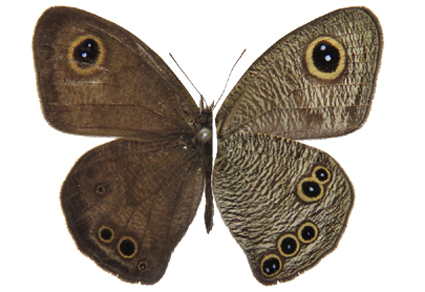Abstract
In this paper, Ypthima persimilis Elwes & Edwards, 1893 and its closely related species, including Y. atra Cantlie & Norman, 1959, Y. microconjuncta Lang, 2024, Y. angustipennis Takáhashi, 2000 and Y. luxurians Forster, 1948, are studied. Among them, Ypthima persimilis and Y. atra are very similar species in appearance and sympatric from N.E. India to S.W. China (S. Yunnan) and N. Vietnam. For a reliable specific identification of these species, diagnoses are provided mainly based upon androconia and male genitalia features. Consequently, the taxon Ypthima atra taiwana Lamas, 2010 from Taiwan Island is reinstated to its specific status, viz. Y. taiwana stat. rev. Their ranges in China are discussed and a distributional map for all species is provided.
References
- Cantlie, K. & Norman, T. (1958) Notes on the Butterfly genus Ypthima. Journal of the Bombay Natural History Society, 56 (1), 66–71.
- D’Abrera, B. (1985) Butterflies of the Oriental Region. II. Nymphalidae, Satyridae & Amathusidae. Hill House Publishers, Melbourne, 245–534 pp.
- Eliot, J.N. (1967) The Sakra Moore, 1857, Section of the Satyrid Genus Ypthima Hübner. Entomologist, 100 (2), 48–61.
- Elwes, H.J. & Edwards, J. (1893) A revision of the genus Ypthima, with especial reference to the characters afforded by the male genitalia. Transactions of the Entomological Society of London, 1893 (1), 1–54, pls. 1–3. https://doi.org/10.1111/j.1365-2311.1893.tb02051.x
- Forster, W. (1948) Beiträge zur Kenntnis der ostasiatischen Ypthima-Arten (Lep. Satyrid.). Mitteilungen der Münchner Entomologischen Gesellschaft, 34, 472–492.
- Fruhstorfer, H. (1908) Neue Rhopaloceren von Formosa. Entomologische Zeitschrift, Stuttgart, 22 (29), 118–119.
- Hsu, Y.F. (2013) The butterflies of Taiwan. 3. Nymphalidae. Morning Star Publishing Inc., Taipei, 381 pp.
- Hsu, Y.F., Liang, J.Y., Huang, C.W. & Shen, Z.Y. (2021) Butterfly Fauna of Taiwan, Vol. V, Nymphalidae. Forestry Bureau, Council of Agriculture, Executive Yuan, Taipei, 847 pp., 141 pls.
- Lamas, G. (2010) Nomenclatural notes on Satyrinae (Lepidoptera: Nymphalidae). SHILAP Revista de lepidopterología, 38 (150), 197–204.
- Lang, S.Y. (2022a) The Nymphalidae of China (Lepidoptera, Rhopalocera). Part III. Satyrinae (partim): Tribe Satyrini (partim): Subtribes Mycalesina, Coenonymphina, Melanargiina, Maniolina, Satyrina, Ypthimina, Erebiina, Euptychiina, Tribe Elymniini, Tribe Zetherini, Tribe Melanitini. Tshikolovets Publications, Pardubice, 376 pp., 68 pls.
- Lang, S.Y. (2022b) Corrigendum for “Lang, S. Y. (2022): The Nymphalidae of China (Lepidoptera, Rhopalocera). Part III. - Tshikolovets Publications, Pardubice.” (Lepidoptera, Nymphalidae, Satyrinae). Atalanta, 53 (3/4), 374.
- Lang, S.Y. (2024a) Descriptions of two new species and a new subspecies of the genus Ypthima Hübner, 1818 from W. Guizhou, S.W. China (Lepidoptera, Nymphalidae, Satyrinae). Atalanta, 55 (1/2), 235–243.
- Lang, S.Y. (2024b) Description of a new species of the Ypthima sakra Moore, [1858]-group from E. Guizhou, S.W. China. Atalanta, 55 (1/2), 244–247.
- Leech, J.H. (1892) Butterflies from China, Japan, and Corea 1 & 2. R. H. Porter, London, 681 pp., 43 pls. https://doi.org/10.5962/bhl.title.86314
- Nakamura, N. & Wakahara, H. (2012) A revised checklist of the butterflies of the Lao P. D. R. (Insecta: Lepidoptera). Evolutionary Sciences, 17, 19–85.
- Seitz, A. (1908–1928) The Macrolepidoptera of the world 9. Alfred Kernen, Stuttgart, 1197 pp., 177 pls.
- Shima, H. (1988) Phylogenetic relationships of the genus Ypthima Hübner (Lepidoptera, Satyridae). Special Bulletin of Lepidopterological Society of Japan, 4, 69–81.
- Shirôzu, T. & Shima, H. (1979) On the natural groups and their phylogenetic relationships of the genus Ypthima Hübner mainly from Asia (Lepidoptera: Satyridae). Sieboldia, 4, 231–295.
- Shizuya, H., Watanabe, Y., Saito, M. & Soe, T. (2005) Basic information on butterflies of Kachin state, Myanmar (PART 3). Butterflies (S. fujisanus), 40, 38–46.
- Takáhashi, M. (2000) A revision of the Ypthima sakra group (Lepidoptera, Satyridae) in Taiwan, China, with description of a new species. Transactions of the Lepidopterological Society of Japan, 51 (1), 1–18.
- Uémura, Y. (2020) A synonymic list of the sakra-group of the genus Ypthima Hübner (Lepidoptera: Nymphalidae, Satyrinae). Bulletin of the Toyosato Museum of Entomology, 30, 1–20.
- Uémura, Y. (2023a) Description of a new species of the genus Ypthima Hübner from Myanmar (Lepidoptera: Nymphalidae, Satyrinae). Bulletin of the Toyosato Museum of Entomology, 33, 1–3.
- Uémura, Y. (2023b) Identification guide to the sakra-group of the genus Ypthima Hübner (Lepidoptera: Nymphalidae, Satyrinae). Evolutionary Sciences, 22, 3–20.
- Wakeham-Dawson, A. & Kudrna, O. (2000) A quantitative description of androconia from Staudinger’s Pseudochazara de Lesse, 1951 (Lepidoptera: Nymphalidae, Satyrinae) type specimens in the Zoological Museum of the Humboldt University of Berlin. Entomologist’s Gazette, 51, 75–81.
- Wakeham-Dawson, A., Kudrna, O. & Dennis, R.L.H. (2007) Description of androconia in the Palaearctic Asian Pseudochazara baldiva (Moore, 1865) butterfly species-group (Nymphalidae: Satyrinae) with designation of two lectotypes and reference to type and other material in the Natural History Museum, London. Nota Lepidopterologica, 30 (2), 211–223.


